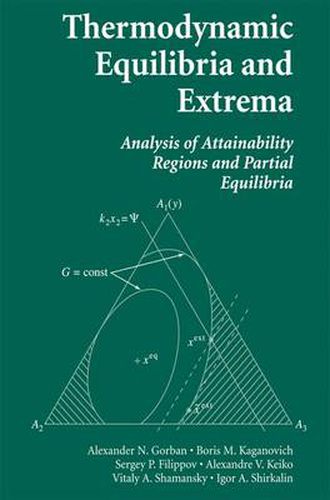Readings Newsletter
Become a Readings Member to make your shopping experience even easier.
Sign in or sign up for free!
You’re not far away from qualifying for FREE standard shipping within Australia
You’ve qualified for FREE standard shipping within Australia
The cart is loading…






This title is printed to order. This book may have been self-published. If so, we cannot guarantee the quality of the content. In the main most books will have gone through the editing process however some may not. We therefore suggest that you be aware of this before ordering this book. If in doubt check either the author or publisher’s details as we are unable to accept any returns unless they are faulty. Please contact us if you have any questions.
The authors are very glad to see the publication ofThermodynamicEquilibriaand Extrema in English and would like to express their gratitude to everybody who contributed to this end. The book is devoted to the analysis of attainability regions and partial equilibria in physicochemical and other systems. This analysis employs the extreme models ofclassicalequilibriumthermodynamics. Considerationisgiventotheproblemof choosing, from the set of equilibrium states belonging to the attainability regions, that equilibrium corresponding to the extreme values of a property of interest to a researcher. For example, one might desire to maximize the concentration of target products of a chemical reaction. The problem of coordinating thermodynamics and kinetics is very important in the analysis presented. Ataglance,itmayseemthattheobjectsofstudyinthermodynamics(thescience ofequilibria)andkinetics(thescienceofmotiontowardequilibrium)coincideonly in the case of complete and ?nal equilibrium. In reality, joint application of th- modynamics and kinetic models gives a clearer understanding of the regularities of the kinetics involved. Relativity of the notions of rest and motion was already ?rmly established in mechanics when the principles of equilibrium were formulated by Galilei, D'Alembert, and Lagrange. Historically, the theories of motion and equilibrium states are related. It is precisely the study of gas kinetics that led Clausius and Boltzmann to the main principles of thermodynamics. The systematic analysis of theseprinciplesintheclassicbookbyGibbs,OntheEquilibriumofHeterogeneous Substances [54], demonstrated the feasibility of substituting the models of rest for themodelsofmotionwhenstudyingvariousphysicochemicalprocesses.
$9.00 standard shipping within Australia
FREE standard shipping within Australia for orders over $100.00
Express & International shipping calculated at checkout
This title is printed to order. This book may have been self-published. If so, we cannot guarantee the quality of the content. In the main most books will have gone through the editing process however some may not. We therefore suggest that you be aware of this before ordering this book. If in doubt check either the author or publisher’s details as we are unable to accept any returns unless they are faulty. Please contact us if you have any questions.
The authors are very glad to see the publication ofThermodynamicEquilibriaand Extrema in English and would like to express their gratitude to everybody who contributed to this end. The book is devoted to the analysis of attainability regions and partial equilibria in physicochemical and other systems. This analysis employs the extreme models ofclassicalequilibriumthermodynamics. Considerationisgiventotheproblemof choosing, from the set of equilibrium states belonging to the attainability regions, that equilibrium corresponding to the extreme values of a property of interest to a researcher. For example, one might desire to maximize the concentration of target products of a chemical reaction. The problem of coordinating thermodynamics and kinetics is very important in the analysis presented. Ataglance,itmayseemthattheobjectsofstudyinthermodynamics(thescience ofequilibria)andkinetics(thescienceofmotiontowardequilibrium)coincideonly in the case of complete and ?nal equilibrium. In reality, joint application of th- modynamics and kinetic models gives a clearer understanding of the regularities of the kinetics involved. Relativity of the notions of rest and motion was already ?rmly established in mechanics when the principles of equilibrium were formulated by Galilei, D'Alembert, and Lagrange. Historically, the theories of motion and equilibrium states are related. It is precisely the study of gas kinetics that led Clausius and Boltzmann to the main principles of thermodynamics. The systematic analysis of theseprinciplesintheclassicbookbyGibbs,OntheEquilibriumofHeterogeneous Substances [54], demonstrated the feasibility of substituting the models of rest for themodelsofmotionwhenstudyingvariousphysicochemicalprocesses.